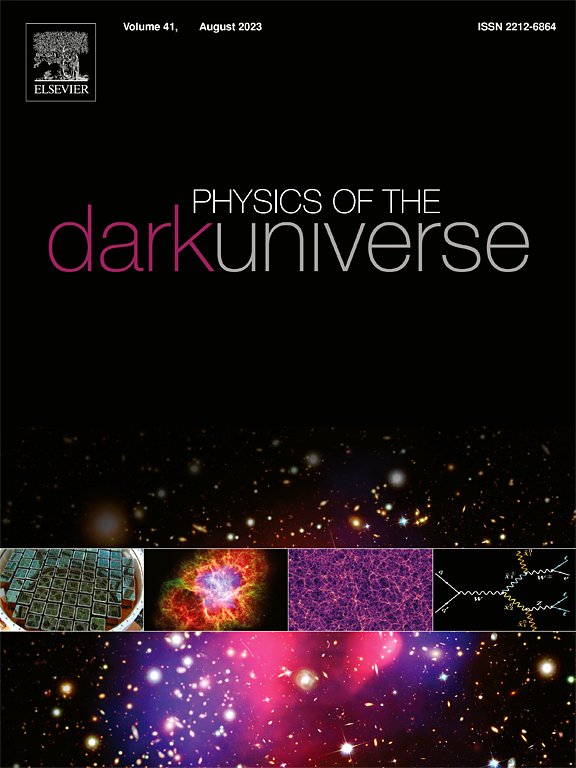Lorentz-violating and topological effects on gravitational lensing phenomena and wave optics in wormhole backgrounds
IF 6.4
2区 物理与天体物理
Q1 ASTRONOMY & ASTROPHYSICS
引用次数: 0
Abstract
In this paper, we present a comprehensive analysis of photon trajectories and electromagnetic wave propagation in Lorentz-violating wormhole (LVWH) spacetimes embedded with topological defects-specifically, a cosmic string (CS) and a global monopole. We begin by deriving the equations of motion for null geodesics and analyze the behavior of photon paths in relation to the wormhole throat radius and parameters characterizing Lorentz symmetry violation. An explicit expression for the photon deflection angle is obtained, which is then used to derive a lens equation. We show that both the cosmic string parameter and Lorentz-violating terms significantly modify this equation compared to the standard Ellis–Bronnikov–Morris–Thorne wormhole (EBMTWH) case. To go beyond the geometric optics approximation, we formulate the scalar Helmholtz wave equation in the curved LVWH background. The resulting effective potential governing wave propagation is shown to be strongly dependent on the throat size, cosmic string parameter, and Lorentz-violating contributions. This leads to a spatially varying refractive index, indicating substantial alterations in the optical properties of the spacetime due to these effects. We extend the analysis to a second LVWH scenario embedded with a global monopole charge. A parallel treatment reveals how the interplay between the monopole parameter, throat radius, and Lorentz-violating terms influences both the lens equation and wave propagation characteristics. Our results highlight how topological defects combined with Lorentz symmetry breaking lead to distinctive modifications in both ray and wave optics, offering potential observational signatures and deeper insights into exotic gravitational structures.
虫洞背景下引力透镜现象和波光学的洛伦兹违反效应和拓扑效应
在本文中,我们全面分析了嵌入拓扑缺陷的违反洛伦兹虫洞(LVWH)时空中的光子轨迹和电磁波传播,特别是宇宙弦(CS)和全局单极子。我们首先推导了零测地线的运动方程,并分析了光子路径与虫洞喉道半径和表征洛伦兹对称违反的参数的关系。得到了光子偏转角的显式表达式,并以此推导出透镜方程。我们证明了宇宙弦参数和违反洛伦兹的项与标准埃利斯-布朗尼科夫-莫里斯-索恩虫洞(EBMTWH)情况相比,显著地修正了这个方程。为了超越几何光学近似,我们在弯曲LVWH背景下建立了标量亥姆霍兹波动方程。结果表明,控制波传播的有效势强烈依赖于喉道大小、宇宙弦参数和违反洛伦兹的贡献。这导致了空间变化的折射率,表明由于这些影响,时空的光学性质发生了实质性的变化。我们将分析扩展到嵌入全局单极电荷的第二个LVWH场景。平行处理揭示了单极参数、喉部半径和洛伦兹违反项之间的相互作用如何影响透镜方程和波的传播特性。我们的研究结果强调了拓扑缺陷与洛伦兹对称破缺的结合如何导致射线和波光学的独特变化,提供了潜在的观测特征和对奇异引力结构的更深入了解。
本文章由计算机程序翻译,如有差异,请以英文原文为准。
求助全文
约1分钟内获得全文
求助全文
来源期刊

Physics of the Dark Universe
ASTRONOMY & ASTROPHYSICS-
CiteScore
9.60
自引率
7.30%
发文量
118
审稿时长
61 days
期刊介绍:
Physics of the Dark Universe is an innovative online-only journal that offers rapid publication of peer-reviewed, original research articles considered of high scientific impact.
The journal is focused on the understanding of Dark Matter, Dark Energy, Early Universe, gravitational waves and neutrinos, covering all theoretical, experimental and phenomenological aspects.
 求助内容:
求助内容: 应助结果提醒方式:
应助结果提醒方式:


